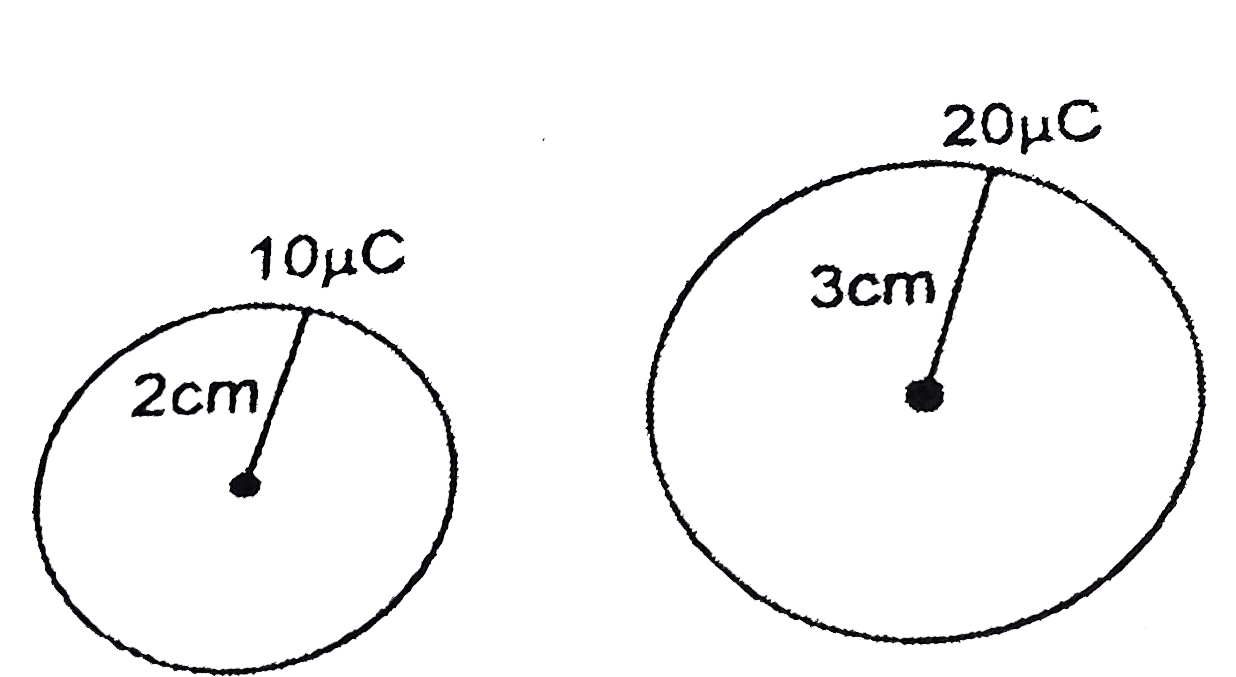Two metallic spheres of radii and are given charges and respectively. If they are connected by a conducting wire, the final charge on the smaller sphere is
The correct Answer is:D
To solve the problem, we need to determine the final charge on the smaller sphere after they are connected by a conducting wire. Here is the step-by-step solution:
Step 1: Understand the initial conditions
We have two metallic spheres:
- Sphere 1 (smaller): Radius r1=1cm=0.01m with charge Q1=10−2C
- Sphere 2 (larger): Radius r2=2cm=0.02m with charge Q2=5×10−2C
Step 2: Calculate the total charge
The total charge Qtotal when the spheres are connected is:
Qtotal=Q1+Q2=10−2+5×10−2=6×10−2C
Step 3: Set up the equation for equal potential
When the spheres are connected, they will share the total charge until their potentials are equal. The potential V of a sphere is given by the formula:
V=kQR
where k is Coulomb's constant, Q is the charge on the sphere, and R is the radius of the sphere.
Let Qf be the final charge on the smaller sphere. Therefore, the charge on the larger sphere will be Qtotal−Qf.
Step 4: Write the equation for equal potentials
The potentials of the two spheres must be equal:
kQfr1=k(Qtotal−Qf)r2
Step 5: Simplify the equation
Since k cancels out, we can simplify the equation:
Qfr1=Qtotal−Qfr2
Substituting the values of r1 and r2:
Qf0.01=6×10−2−Qf0.02
Step 6: Cross-multiply and solve for Qf
Cross-multiplying gives:
0.02Qf=0.01(6×10−2−Qf)
Expanding this:
0.02Qf=0.006−0.01Qf
Combining like terms:
0.02Qf+0.01Qf=0.006
0.03Qf=0.006
Dividing both sides by 0.03:
Qf=0.0060.03=0.2C
Step 7: Final charge on the smaller sphere
Thus, the final charge on the smaller sphere is:
Qf=0.2C
We have two metallic spheres:
- Sphere 1 (smaller): Radius r1=1cm=0.01m with charge Q1=10−2C
- Sphere 2 (larger): Radius r2=2cm=0.02m with charge Q2=5×10−2C
The total charge Qtotal when the spheres are connected is:
Qtotal=Q1+Q2=10−2+5×10−2=6×10−2C
When the spheres are connected, they will share the total charge until their potentials are equal. The potential V of a sphere is given by the formula:
V=kQR
where k is Coulomb's constant, Q is the charge on the sphere, and R is the radius of the sphere.
The potentials of the two spheres must be equal:
kQfr1=k(Qtotal−Qf)r2
Since k cancels out, we can simplify the equation:
Qfr1=Qtotal−Qfr2
Qf0.01=6×10−2−Qf0.02
Cross-multiplying gives:
0.02Qf=0.01(6×10−2−Qf)
Expanding this:
0.02Qf=0.006−0.01Qf
Combining like terms:
0.02Qf+0.01Qf=0.006
0.03Qf=0.006
Dividing both sides by 0.03:
Qf=0.0060.03=0.2C
Thus, the final charge on the smaller sphere is:
Qf=0.2C
Topper's Solved these Questions
- BOOK - A2ZCHAPTER - ELECTRIC POTENTIAL & CAPACITANCEEXERCISE - Grouping Of Capacitors48videos
ELECTRIC POTENTIAL & CAPACITANCE
- BOOK - A2ZCHAPTER - ELECTRIC POTENTIAL & CAPACITANCEEXERCISE - Capacitor Circuits52videos
ELECTRIC POTENTIAL & CAPACITANCE
- BOOK - A2ZCHAPTER - ELECTRIC POTENTIAL & CAPACITANCEEXERCISE - Capacitor32videos
ELECTRIC POTENTIAL & CAPACITANCE
- BOOK - A2ZCHAPTER - ELECTRIC CHARGE, FIELD & FLUXEXERCISE - Section D - Chapter End Test29videos
ELECTRIC CHARGE, FIELD & FLUX
- BOOK - A2ZCHAPTER - ELECTROMAGNETIC INDUCTIONEXERCISE - Section D - Chapter End Test30videos
ELECTROMAGNETIC INDUCTION
Similar Questions
Figure shows two conducting spheres separated by large distance and of radius 2 cm and 3 cm containing charges 10μC and 20μC respectively. When the spheres are connected by a conducting wire then find out following :
(i) Ratio of the final charge.
(ii) Final charge on each sphere.
(iii) Ratio of final charge densities.
(iv) Heat produced during the process.
 View Solution
View SolutionTwo metallic sphere of radii 1cm and 3cm are given charges of 4×10−2C and respectively. If these are connected by a counducting wire, the final charge on the bigger sphere is
View Solution
Knowledge Check
- Question 1 - Select One
Two metallic spheres of radius 1 cm and 2 cm are given charge 10−2and5×10−2 C respectively. If they are connected by a conducting wire, the final charge on the smaller sphere is
A3×10−2 CB2×10−2 CC1×10−2CD6×10−2 C - Question 2 - Select One
Two metallic spheres of radii 1 cm and 3 cm are given charges of −1×10−2C and 5×10−2C , respectively . If these are connected by a conducting wire , the final charge on the bigger sphere is
A2×10−7CB3×10−2CC4×10−2CD1×10−2C - Question 3 - Select One
Two metallic spheres of radii 1 cm and 3 cm are given charges of −1×10−2C and 5×10−2C , respectively . If these are connected by a conducting wire , the final charge on the bigger sphere is
A2×10−2CB3×10−2CC4×10−2CD1×10−2C
Two spheres of radii 1 cm and 2 cm have been charged with 1.5×10−8and0.3×10−7 coulomb of posiitve charge. When they are connected with a wire, charge :
View SolutionTwo metal spheres of radii 0.01 m and 0.02 m are given a charge of 15 mC and 45 mC, respectively. They are then connected by a wire. The final charge on the first is …×10−3C.
View SolutionTwo spheres of radii 1 cm and 2 cm have been charged with 1.5×10−8and0.3×10−7 coulomb of posiitve charge. When they are connected with a wire, charge :
View SolutionTwo conducting spheres of radii 5cm and 10cm are given a charge of 15μF each. After the two spheres are joined by a conducting wire, the charge on the smaller sphere is
View SolutionTwo insulated metal spheres of raddi 10 cm and 15 cm charged to a potential of 150 V and 100 V respectively, are connected by means of a metallic wire. What is the charge on the first sphere?
View Solution

